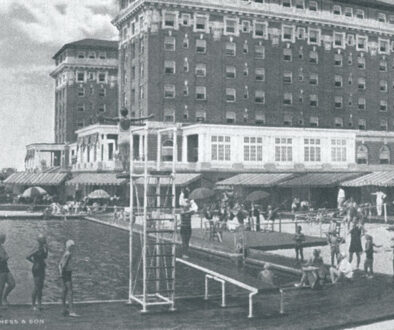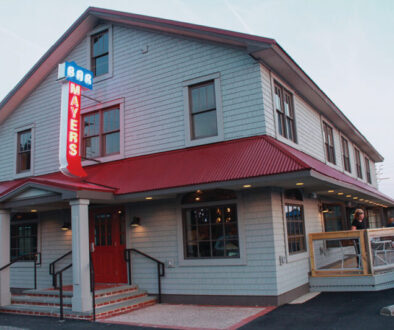The Summer Place
“We shape our dwellings, and afterwards our dwellings shape us.”
Winston Churchill
Houses are built of bricks and mortar. Homes are made of ghosts and memories. For the Dean family, all are inextricably entwined.
Last year, when their summer place in Avalon went up for auction, two generations of Deans joined forces to save the 123-year-old Victorian house, which they plan to relocate to Cape May.
The story began in 1955, when family patriarch Robert Lewis Dean, an executive for pharmaceutical company Smith, Kline and French, bought the house at 254 Sixth Street in Avalon. The price was $9,000 (the equivalent of about $82,000 today). Dean’s purchase raised some eyebrows. Back then, having a second home—and a shore home, to boot!—was considered by most to be quite an extravagance.

“My grandparents thought my parents were crazy,” says Dean’s daughter, Maryann Dean Buonomo of Glenside, Pennsylvania, a longtime piano teacher who also works in her husband’s medical office. “But to my loving, generous father with a young boy’s heart, well, this was a 70-year-old Queen Anne with a widow’s peak and a tower—a child’s dream!”
In 2017, when the long-vacant house was sold—this time for a cool $1.1 million—its future looked pretty grim. Not surprisingly, the realtor bought the property only to redevelop it. That meant tearing down one of the earliest—and oldest—homes in the borough.
Crowded House
Avalon in the 1950s and ’60s may have been unrecognizable from the tony enclave of today. Maryann describes it as both “a mosquito-ridden country town,” and “an incredible, magical place to spend your summers”—an island fairly overrun with trumpet vines and reeds, swarming with toads and turtles and other wildlife.
The streets were lined with “country cottages, four-squares, and the occasional Jetson-style modern house,” says Maryann. The Dean place stood out from the rest, with its stained glass, Victorian embellishments, and “flaking, fish-scale shingles.”
It was surrounded by dune grasses so high—15 to 20 feet in some places—that the family patriarch had to cut a path to the nearby beach and then line it with rickety boards. “It was like his own little Panama Canal,” says Maryann’s brother, James, a retired broadcaster who spent most of his adult life in Southern California. “I can still remember the sound the boards made as you ran across to the beach. It was the most joy I ever felt in my life.”
The house’s generous porch “spilled over with people for decades,” says Maryann. “It was always packed, with my mother making flounder dinners for 15.” She recalls countless Monopoly and Scrabble games, water fights, her five brothers’ constant horseplay, treasure hunts on the beach, and of course, turtle-napping.
“The woods were filled with box turtles, and when you caught them they would pee in your hand,” says James. “We would catch them and put them in pens. We didn’t want to let them go.” But their kindly father said, “Paint your name on their bellies, and then you can catch them again next year.”
“That never happened,” says James with a laugh, “but it was sure fun.”
There were other diversions, like the Avalon movie house, a converted 1920s dancehall where the whole brood flocked to see The Guns of Navarone, The Great Escape, and The Parent Trap. Another favorite stop was the local candy store owned by “a little old lady we called ‘Mom,’” says James. “You could get a whole bag of candy for a quarter.” Two bits went a long way back then. Pizza, too, was 25 cents a slice. And a ride on the trampoline? Yep, a quarter for 30 minutes.
Despite these delights, the chief attraction remained the house, which cast its spell on just about everyone. The most popular feature was the third-floor cupola, the kids’ favorite hangout and a landmark so distinctive it was featured on mariners’ maps of the 18th century.
Part of the tower’s charm: a uniquely contemporaneous history of many of the people who passed through over the years. Starting in the 1940s, it became a tradition for visitors to scrawl messages on the white tower walls. Robert Lewis Dean himself christened the wall in 1974, with a verse saying: “This is the doggerel wall/Where childish wit and wisdom scrawl.”



Other hand-written messages include these:
“To a great summer and a little hell-raisen!”
“Came alive in ’75/Back for more kicks in ’76.”
The household graffiti includes news events as well. A message from 1974 reads, “Avalon is evacuating. Hurricane Bell [Belle] is on its way.” One from 1986 made note of the Space Shuttle Challenger disaster.
And then there’s this prophetic plea: “To any one of the Deans, please do not sell this house. There are too many memories here.”
Storm Warning
Built in 1895 by Avalon borough’s first treasurer and tax collector, George W. Kates, the house was located at the northeast inlet, making it especially vulnerable it to the elements. “As children, we always worried about it being lost to a storm,” says another of the siblings, Christopher Dean, a builder who lives in Wyncote, Pennsylvania. The house was in real danger of being washed away in the catastrophic nor’easter of March 1962, he says.
“I was nine, and I remember it well. We followed the progress of the storm, and afterward went out on boats to see if the house was still there. It was the first house on the island that remained. All the others were wiped out—and several of them were in our backyard.”
That mighty storm “changed the structure of the island and reconfigured nature,” according to James. “Avalon permanently transformed for the worse. After that storm, I never saw a toad again.” Along with hurricanes, floods and nor’easters, over the years the house survived two lightning strikes.
But it wouldn’t survive the wrecking ball.
By 1996, with the seven Dean siblings grown and married and their parents gone, the decision was made to sell the beloved summer place. For most, it was a wrenching decision. They were relieved to discover that the new owner—unlike the tear-down crowd—cherished the place and promised to improve on it. He made good on that promise, rewiring the house, installing new plumbing, restoring the plaster walls and refinishing the floors.
“He spend the better part of 10 years restoring the house in keeping with the Victorian style,” says Christopher. “He had a blacksmith come in and put ironwork around the shutters and had wooden storm windows built. He yanked out the stained glass windows and re-roped them.
“I thought, ‘That house will be preserved. He has assured it.’”
But nothing is forever, particularly when it comes to seashore real estate. In the late 2000s, when the recession hit, the new owner lost the house. For more than a decade thereafter, it sat empty—not occupied, not for sale, in a sad state of limbo. From time to time, when they were in town, members of the Dean family would walk or drive by, just to reassure themselves that it was still standing. Then they saw the auction notice.
“I knew then how the story would end,” says Christopher. “Every historic house in Avalon, no matter what its value, goes. There is no preservation in the town.”
According to the Deans, borough officials seemed disinterested in the fate of one of Avalon’s oldest structures. The local Historical Society was powerless to help, possibly because the house was not yet listed in the state or National Register of Historic Places.
“I didn’t go to the auction,” says Christopher. “I couldn’t bear to see it sold. I knew it was all over.”
But what looked like the end of the road was really just a jug handle. “When you have a dream by yourself, it’s just a dream,” says Christopher. “If you have dream with somebody else, it can become a reality. And that is precisely what happened.”
Good Save
Last December, on a chilly Saturday morning, James Dean stood on Sixth Street across from the old summer place, privately saying goodbye. That’s when he spotted someone seated in a car at the curb. Thinking it might be the buyer or developer, he walked over. He was startled to see it was his niece, Adrienne Scharnikow, the oldest of his parents’ 16 grandchildren. They had not seen each other in years.
According to James, as soon as they recognized each other, they blurted in unison, “What can we do? How can we save this house?”
Once again, the family appealed for help to local officials and the Historical Society; the latter asked only to be allowed to enter and take pictures of the house before it was torn down.
“At that point,” says Christopher, “we knew the house could only be preserved by getting it out of Avalon.” The best destination, they agreed, was Cape May, where the 1895 house would actually be a youngster among the some of the town’s venerated Victorians.
Adrienne, a clinical scientist at Merck, offered to buy the house from realtor Jerry Raffa, who agreed, provided it was moved off the lot at once. She wrote a five-figure check, then summoned SJ Hauck House Movers.




In children’s fiction, houses move in wondrous ways. They are swept up in twisters, as in The Wizard of Oz; borne aloft by helium balloons à la Up; or blown sky-high by a big, bad wolf as told in The Three Little Pigs. In reality, moving a house is a tedious, painstaking operation with many slow moving parts.
“The job went good, for a last-minute thing,” says Steve Hauck, president of the moving company. “We were hired on a Friday and started on Monday, with two weeks to get it out of there.” Working overtime, a crew of 15 dismantled the 90-ton structure like a Lego house, severing all the electrical wiring and plumbing at the source and readying it for transport.
“Without using any jargon, all the points that hold the structure together are transferred onto steel beams and rigging in the areas that need support,” says Hauck, in essence building an infrastructure to transfer the house off the original foundation. Because it would be traveling on local streets and highways, over and under parkway bridges, skirting trees and power lines, the house was dismantled first.
Flanked by escort vehicles front and back, and traveling at a crawl, it was hauled in five pieces to its temporary home, a salvage yard in Egg Harbor Township. And there it sits today.
Homeward Bound
“The day we took that house away, we saw neighbors we hadn’t seen in years,” all of whom came to bid it farewell, says Adrienne. The next step is scouting locations in Cape May, an arduous task that comes with its own deadline.
“I have pressure to get the house out of storage because with no foundation, the floorboards may start to settle,” she says. “Land is expensive in Cape May, and financially, the numbers have to make sense. By now I’m pretty familiar with all the rules and regulations, but I never thought there would be so many ordinances and so much paperwork to find this house a home. It’s making me a lot more patient.”


Right: James getting to touch the weathervane again in 2018 at 64 years old.
It was, Maryann says, “the save of the century.” In the end, she believes, even if she has to sell the house to save it, the journey will have been worthwhile.
“This house survived 123 years. It deserved a happy ending, and I knew in my heart it was coming to Cape May.”



